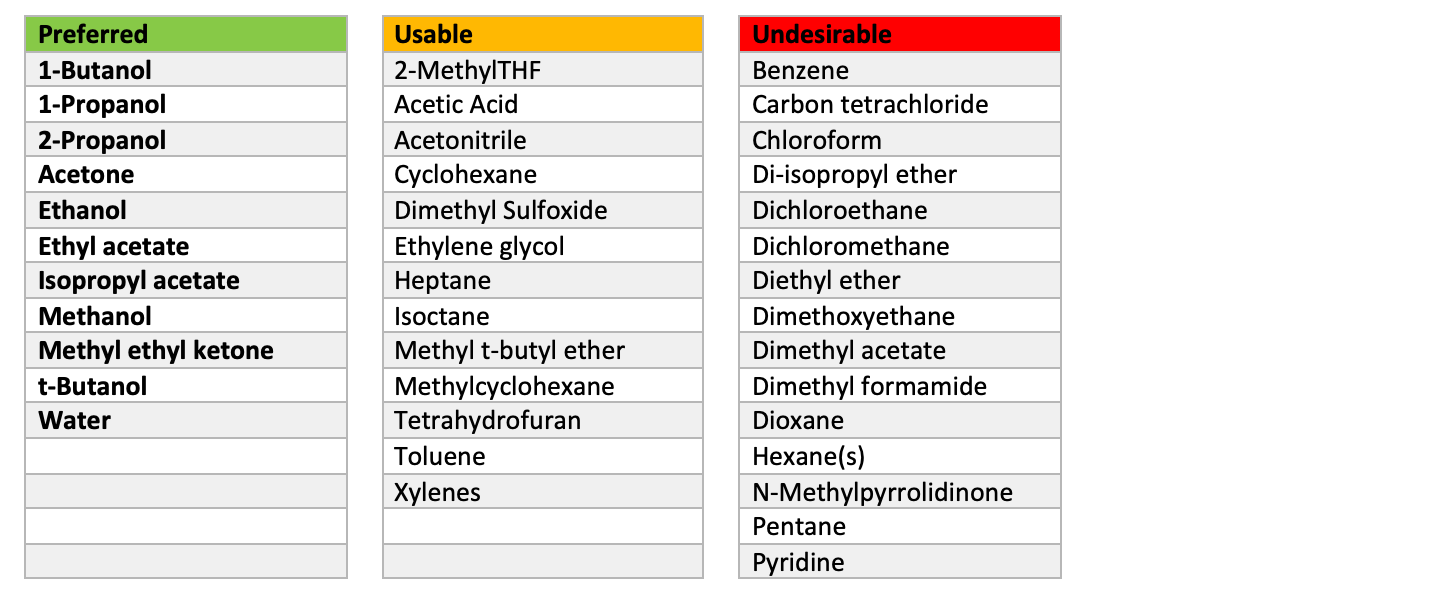Last Revised: December 19, 2018
Revision 6/2018, posted 11/2018
Use This, Not That!
This Fact Sheet offers suggestions for selection of solvents for use in chemical reactions, extractions, and purifications in chemical research labs.
The Environmental, Health and Safety (EHS) group at Pfizer Global Research and Development initiated a project to assess the suitability of common solvents based on criteria of (i) Worker Safety, (ii) Process Safety, and (iii) Environmental and regulatory considerations. The recommendations below are adapted from their published content in Green Chem., 2008,10, 31-36 (DOI: 10.1039/B711717E).

|
Avoid Using |
TLV* (ppm) |
Why is it bad? |
Potential Alternative |
|
Benzene |
0.5** |
Carcinogen, low TLV, Classified as a hazardous airborne pollutant |
Toluene |
|
Carbon tetrachloride |
5 |
Carcinogen, toxic, depletes ozone, Classified as a hazardous airborne pollutant |
Dichloromethane |
|
Chloroform |
10 |
Classified as a hazardous airborne pollutant, carcinogen |
Dichloromethane |
|
Di-isopropyl ether |
250 |
Powerful peroxide former |
2-MeTHF or tert-butyl methyl ether |
|
Dichloroethane |
10 |
Classified as a hazardous airborne pollutant, carcinogen |
Dichloromethane |
|
Dichloromethane (for chromatography) |
100 |
Classified as a hazardous airborne pollutant, carcinogen |
Ethyl Acetate/Heptane |
|
Dichloromethane (for extractions) |
100 |
Classified as a hazardous airborne pollutant, carcinogen |
Ethyl Acetate, MTBE, Toluene, 2-MeTHF |
|
Diethyl ether |
400 |
Low flash point |
2-MeTHF or tert-butyl methyl ether |
|
Dimethly formamide |
10** |
Classified as a hazardous airborne pollutant, toxic |
Acetonitrile |
|
Dimethoxy ethane |
Data not determined |
Carcinogen, toxic |
2-MeTHF or tert-butyl methyl ether |
|
Dimethyl acetamide |
10** |
Toxic |
Acetonitrile |
|
Dioxane |
20** |
Classified as a hazardous airborne pollutant, carcinogen |
2-MeTHF or tert-butyl methyl ether |
|
Hexane |
50 |
More toxic than alternative |
Heptane |
|
N-methly pyrrolidinone |
Data not determined |
Toxic |
Acetonitrile |
|
Pentane |
None established |
Low flash point |
Heptane |
|
Pyridine |
1 |
Carcinogen/mutagenic/ reproductive hazard, low TLV |
Triethylamine (if pyridine is used as base) |
*TLV = American Conference of Governmental Industrial Hygienists. Threshold Limit Values for Chemical Substances and Physical Agents and Biological Exposure Indices.
** Skin notation, indicates significant contribution to the overall exposure by cutaneous absorption
Related SOPs and Fact Sheets
Fact Sheet: Controlling Chemical Vapors in the Laboratory